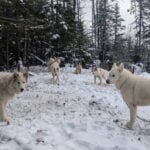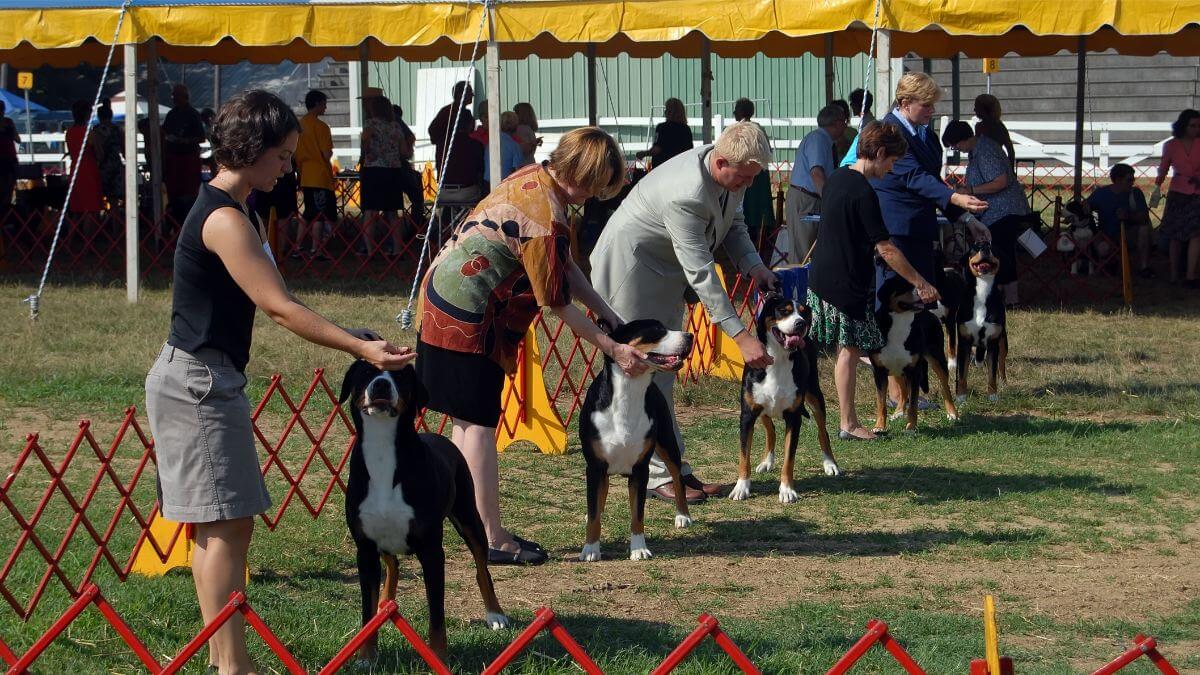


Home » Judging the Greater Swiss Mountain Dog

This article was originally published in Showsight Magazine, January 2017 issue.
The Greater Swiss Mountain Dog is a draft and drover breed and should structurally appear as such. It is a striking, tri-colored, large, powerful, confident dog of sturdy appearance. It is a heavy boned and well-muscled dog which, in spite of its size and weight, is agile enough to perform the all-purpose farm duties of the mountainous regions of its origin.
When judging the breed, the general description should give you your overall impression of the dog. This dog originated as a working farm dog. You will quickly realize that there are a very wide range of looks or styles that adequately fit that description. It is important to note that while this breed is one of the four varieties of Sennenhund or Swiss Cattle Dog breeds, it is a separate breed and should not be confused with its cousins the Bernese Mountain Dog or Entlebucher Cattle Dog.
When evaluating size, proportion, and substance, the standard includes dogs from 25½-28½ inches and bitches from 23½-27 inches. Neither the upper nor lower end of these heights are preferred. Judges are reminded that they should always award the best dogs in the ring and not necessarily the biggest dogs. The standard uses the word “powerful,” which should denote strength and power as well as size and substance. Proper evaluation of the GSMD will put great emphasis on the well-conditioned athlete and penalize the overweight and out-of-shape dog. A fat dog could never perform its historic task as an all-purpose farm dog. Such a dog is not a good specimen of the breed. This is a heavy boned, slightly longer than tall dog. The dog should be neither too leggy nor too low to the ground. The breed carries characteristics of their gender. The dogs are larger and more massive throughout and the bitches are more feminine, although never refined or weedy.
This is not a “head” breed, although like all breeds, correct head type and expression are an important part of breed type. There is great variation in head type. The ideal GSMD head is a comparatively long head with a flat back skull and slight stop. From the beginning, a dog was wanted with a “cow-dog” type of skull, with a flat forehead, in distinct contrast to the St. Bernard. The muzzle should be of approximately equal length to the back skull, but should be blunt and not pointed. Unfortunately, most muzzles that approach the correct length tend to be pointed or snipey. Retaining proper length and width of muzzle seems to be challenging. The lips and flews should be tight. Most of the dogs with correct width and depth of muzzle tend to be a little lippy, but a Great Dane look is not desirable. The expression should be animated and gentle with dark brown, almond-shaped eyes preferred. Incorrect eyes are very distracting from the correct headpiece. Blue eyes are a DQ. In adult dogs, the nose leather should be black. All GSMD puppies are born with pink noses and the pigment fills in as they age. It is not unusual to see puppies that still have pink spots on their noses. This should not be faulted. A good GSMD head should all flow together. There should be no sharp angles such as prominent brows and no domey skulls. The head should never appear too big or too little for the body. A common mistake when judging the breed is to award a “big head” with no regard as to whether or not it fits the standard. The standard calls for a scissors bite but with no mouth DQs.
The neck should be of moderate length and strong and muscular. It should be clean, without dewlap. When viewed in profile, the GSMD has a slight protruding prosternum. The body is full with a slight tuck up. The chest should reach the elbow. The depth of chest should be half the total height of the dog at the withers. The topline is level from withers to croup, with the croup smoothly rounded to the tail insertion. The tail is fairly heavy, reaching to the hocks, pendulous in repose. When alert and when moving, the tail is carried at the level of the back or higher, and may be slightly curved upward but should not curl or tilt over the back. A gay tail is undesirable. A tucked tail is an indication of temperament and as temperament is the only trait to be severely penalized, a dog with a tucked tail should not be rewarded on that day. The bones of the tail should feel straight. You must run your hand down the tail to determine if this is a fact. Kinks are not always visible to the eye.
The GSMD is moderately angled front and rear. Balance is the most important attribute. They have well-let-down hocks. The feet are round and compact with well-arched toes. Splayed feet or cat feet are undesirable. Dewclaws in the rear should be removed. Front dewclaws are optional. The GSMD has a double coat. The topcoat is dense and varies in length from 1¼” to 2″. That is the length of coat found on the neck and possibly on the rear. The length of coat on the head and legs is much shorter. Undercoat must be present and may be showing. It varies in color from the preferred dark gray to tawny, often with a variation in color on a single dog. It is usually lightest around the neck and darkest throughout the body. The best place to check for undercoat is on the shoulder, neck, or thigh. Some GSMD have an agouti coat with banded hairs. As long as this does not detract from the “striking tri-colored” appearance of the breed, it should not be faulted. Blue and red GSMDs are DQed. These are obvious as the blue is the color of a Weimaraner and the red is the color of a St. Bernard. These DQs are not referring to a red tinge in the coat or agouti hairs or undercoat visible through the black topcoat.
The GSMD standard goes to extensive length in describing the tri-colored black, white, and rich rust markings that are characteristic of all of the Sennenhunds. Unlike their Sennenhund cousins, white patches or white collars on the neck are permitted. Symmetry of markings is desired, but if a judge is agonizing over markings, that would mean that there is a ring full of exceptional dogs to judge. Markings are considered cosmetic and should be considered of lesser importance than temperament, structure, and movement. Markings that detract from the striking tri-colored dog would be penalized to the extent of the deviation.
Proper GSMD movement is neither exaggerated nor cumbersome. They should move with good reach and powerful drive. The back should remain level. On the down and back, the front and rear legs tend to converge. The GSMD is a bold, faithful, willing worker. They should never display vicious behavior nor should they be shy. The only traits to be severely penalized are shyness or aggressiveness. Judges are admonished to severely penalize these behaviors in their ring.
In summary, when judging the GSMD, judges are asked to look for the large, powerful, confident dog which is most suited to its draft and drover duties. Once again, size alone is not an attribute. The dogs should be well-conditioned. Temperament is extremely important and incorrect temperament should be severely penalized. Markings are of lesser importance and in most cases should be used as a tie-breaker. Any other fault that detracts from the described working dog should be penalized to the extent of the deviation.